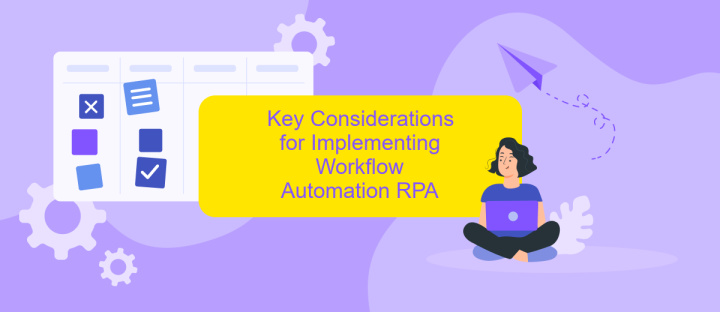Workflow Automation RPA
Workflow automation through Robotic Process Automation (RPA) is revolutionizing the way businesses operate by streamlining repetitive tasks and enhancing efficiency. By leveraging software robots, organizations can automate routine processes, reduce human error, and free up employees for more strategic activities. This article explores the benefits, implementation strategies, and future trends of RPA, providing insights into how it can transform your business operations.
Introduction to Workflow Automation and RPA
Workflow automation and Robotic Process Automation (RPA) are transforming the way businesses operate by streamlining repetitive tasks and enhancing efficiency. These technologies allow organizations to automate routine processes, thereby reducing human error and freeing up employees to focus on more strategic activities.
- Improved efficiency and productivity
- Reduced operational costs
- Enhanced accuracy and compliance
- Scalability and flexibility
One of the key components of successful workflow automation is the integration of various systems and applications. Services like ApiX-Drive facilitate these integrations by allowing seamless data transfer between different platforms without the need for complex coding. This not only simplifies the automation process but also ensures that all systems work in harmony, further enhancing the overall efficiency of the organization.
Benefits and Use Cases of Workflow Automation RPA

Workflow automation through Robotic Process Automation (RPA) offers numerous benefits, including increased efficiency, reduced errors, and cost savings. By automating repetitive tasks, businesses can free up valuable human resources for more strategic activities. Additionally, RPA can operate 24/7, ensuring that workflows are continuous and deadlines are met. This leads to improved overall productivity and a significant reduction in operational costs.
Use cases for workflow automation RPA are diverse and span across various industries. In finance, RPA can automate invoice processing and compliance reporting. In healthcare, it can streamline patient data management and appointment scheduling. For businesses looking to integrate multiple platforms, services like ApiX-Drive facilitate seamless integration, enabling automated data transfer between systems. This ensures that workflows remain uninterrupted and data consistency is maintained across all platforms.
Key Considerations for Implementing Workflow Automation RPA

Implementing Workflow Automation RPA (Robotic Process Automation) requires careful planning and consideration to ensure a smooth and effective transition. Key factors to consider include:
- Process Identification: Identify repetitive and rule-based tasks that are suitable for automation.
- Integration Capabilities: Ensure the RPA tools can seamlessly integrate with existing systems and applications. Services like ApiX-Drive can facilitate these integrations.
- Scalability: Choose an RPA solution that can scale with your business needs.
- Security and Compliance: Ensure that the RPA solution adheres to security standards and compliance regulations.
- Change Management: Develop a strategy to manage the changes in workflows and employee roles.
By addressing these key considerations, organizations can effectively implement Workflow Automation RPA to enhance efficiency, reduce errors, and improve overall productivity. Proper planning and the right tools, such as ApiX-Drive for seamless integrations, are essential for a successful RPA implementation.
Best Practices for Successful Workflow Automation RPA Implementation

Implementing workflow automation with RPA (Robotic Process Automation) requires careful planning and execution to ensure success. Begin by thoroughly analyzing your current processes to identify repetitive tasks that can be automated. Understanding the intricacies of these tasks will help in designing an effective RPA solution.
It is crucial to choose the right tools and platforms for your automation needs. Opt for reliable and scalable solutions that can grow with your business. ApiX-Drive, for instance, offers seamless integration capabilities, making it easier to connect various applications and automate workflows efficiently.
- Conduct a detailed process assessment before automation.
- Select the appropriate RPA tools and platforms.
- Ensure seamless integration using services like ApiX-Drive.
- Monitor and optimize automated processes regularly.
Regular monitoring and optimization are essential to maintain the efficiency of your automated workflows. Continuously evaluate the performance of your RPA implementation and make necessary adjustments to address any issues that arise. By following these best practices, you can achieve a successful and sustainable RPA implementation.
- Automate the work of an online store or landing
- Empower through integration
- Don't spend money on programmers and integrators
- Save time by automating routine tasks
Future Trends and Developments in Workflow Automation RPA
The future of workflow automation RPA (Robotic Process Automation) is set to be shaped by advancements in artificial intelligence (AI) and machine learning (ML). These technologies will enable RPA to handle more complex tasks, adapt to changing environments, and make decisions based on predictive analytics. This evolution will allow businesses to achieve higher levels of efficiency and accuracy, reducing the need for human intervention in routine processes. Additionally, the integration of natural language processing (NLP) will enhance the ability of RPA to interact with unstructured data, broadening its application scope.
Another significant trend is the increasing focus on seamless integration with various software and platforms. Services like ApiX-Drive are paving the way for more straightforward and efficient integrations, allowing businesses to connect disparate systems without extensive coding. This ease of integration will enable organizations to leverage RPA across multiple departments, enhancing overall workflow automation. Furthermore, the development of low-code and no-code platforms will democratize RPA, making it accessible to non-technical users and fostering innovation at all organizational levels.
FAQ
What is Workflow Automation RPA?
How can Workflow Automation RPA benefit my business?
What types of tasks can be automated using RPA?
How do I get started with implementing Workflow Automation RPA?
What are the common challenges in implementing RPA?
Strive to take your business to the next level, achieve your goals faster and more efficiently? Apix-Drive is your reliable assistant for these tasks. An online service and application connector will help you automate key business processes and get rid of the routine. You and your employees will free up time for important core tasks. Try Apix-Drive features for free to see the effectiveness of the online connector for yourself.


